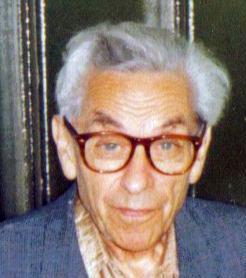Paul Erdős (nonfiction): Difference between revisions
No edit summary |
No edit summary |
||
| Line 3: | Line 3: | ||
Erdős pursued and proposed problems in discrete mathematics, [[Graph theory (nonfiction)|graph theory]], [[Number theory (nonfiction)|number theory]], [[Mathematical analysis (nonfiction)|mathematical analysis]], approximation theory, [[Set theory (nonfiction)|set theory]], and probability theory. | Erdős pursued and proposed problems in discrete mathematics, [[Graph theory (nonfiction)|graph theory]], [[Number theory (nonfiction)|number theory]], [[Mathematical analysis (nonfiction)|mathematical analysis]], approximation theory, [[Set theory (nonfiction)|set theory]], and probability theory. | ||
Much of his work centered around discrete mathematics, cracking many previously unsolved problems in the field. | Much of his work centered around [[Discrete mathematics (nonfiction)|discrete mathematics]], cracking many previously unsolved problems in the field. | ||
He championed and contributed to Ramsey theory, which studied the conditions in which order necessarily appears. | He championed and contributed to Ramsey theory, which studied the conditions in which order necessarily appears. | ||
| Line 13: | Line 13: | ||
Erdős published around 1,500 mathematical papers during his lifetime, a figure that remains unsurpassed. | Erdős published around 1,500 mathematical papers during his lifetime, a figure that remains unsurpassed. | ||
He firmly believed mathematics to be a social activity, living an itinerant lifestyle with the sole purpose of writing mathematical papers with other mathematicians. | He firmly believed mathematics to be a social activity, living an itinerant lifestyle with the sole purpose of writing mathematical papers with other [[Mathematician (nonfiction)|mathematicians]]. | ||
He was known both for his social practice of mathematics (he engaged more than 500 collaborators) and for his eccentric lifestyle (''Time'' magazine called him ''The Oddball's Oddball''). | He was known both for his social practice of mathematics (he engaged more than 500 collaborators) and for his eccentric lifestyle (''Time'' magazine called him ''The Oddball's Oddball''). | ||
| Line 27: | Line 27: | ||
* [[Gnomon algorithm]] | * [[Gnomon algorithm]] | ||
* [[Gnomon Chronicles]] | |||
* [[Mathematician]] | |||
* [[Mathematics]] | * [[Mathematics]] | ||
== Nonfiction cross-reference == | == Nonfiction cross-reference == | ||
* [[Béla Bollobás (nonfiction)]] - Doctoral Student | |||
* [[Discrete mathematics (nonfiction)]] | |||
* [[Lipót Fejér (nonfiction)]] - Doctoral advisor | |||
* [[Graph theory (nonfiction)]] | * [[Graph theory (nonfiction)]] | ||
* [[Joseph Kruskal (nonfiction)]] - Doctoral Student | |||
* [[Mathematician (nonfiction)]] | * [[Mathematician (nonfiction)]] | ||
* [[Mathematics (nonfiction)]] | |||
* [[Number theory (nonfiction)]] | * [[Number theory (nonfiction)]] | ||
* [[George B. Purdy (nonfiction)]] - Doctoral Student | |||
* [[Set theory (nonfiction)]] | |||
* [[Alexander Soifer (nonfiction)]] - Doctoral Student | |||
External links: | External links: | ||
Revision as of 20:15, 18 April 2018
Paul Erdős (Hungarian: Erdős Pál [ˈɛrdøːʃ ˈpaːl]; 26 March 1913 – 20 September 1996) was a Hungarian mathematician.
Erdős pursued and proposed problems in discrete mathematics, graph theory, number theory, mathematical analysis, approximation theory, set theory, and probability theory.
Much of his work centered around discrete mathematics, cracking many previously unsolved problems in the field.
He championed and contributed to Ramsey theory, which studied the conditions in which order necessarily appears.
Overall, his work leaned towards solving previously open problems, rather than developing or exploring new areas of mathematics.
He was one of the most prolific mathematicians of the 20th century. He devoted his waking hours to mathematics, even into his later years—indeed, his death came only hours after he solved a geometry problem in a conference in Warsaw.
Erdős published around 1,500 mathematical papers during his lifetime, a figure that remains unsurpassed.
He firmly believed mathematics to be a social activity, living an itinerant lifestyle with the sole purpose of writing mathematical papers with other mathematicians.
He was known both for his social practice of mathematics (he engaged more than 500 collaborators) and for his eccentric lifestyle (Time magazine called him The Oddball's Oddball).
Erdős's prolific output with co-authors prompted the creation of the Erdős number, the shortest path between a mathematician and Erdős in terms of co-authorships.
In the News
Fiction cross-reference
Nonfiction cross-reference
- Béla Bollobás (nonfiction) - Doctoral Student
- Discrete mathematics (nonfiction)
- Lipót Fejér (nonfiction) - Doctoral advisor
- Graph theory (nonfiction)
- Joseph Kruskal (nonfiction) - Doctoral Student
- Mathematician (nonfiction)
- Mathematics (nonfiction)
- Number theory (nonfiction)
- George B. Purdy (nonfiction) - Doctoral Student
- Set theory (nonfiction)
- Alexander Soifer (nonfiction) - Doctoral Student
External links:
- Paul Erdős @ Wikipedia
- Paul Erdős really got going on speed @ Boing Boing
- The Man Who Loved Only Numbers @ Wikipedia
